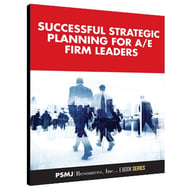 Have you looked at your firm’s organization chart lately? Or do you not even have one? Org charts are useful in firms of all sizes, from just a few people to thousands of employees.
Have you looked at your firm’s organization chart lately? Or do you not even have one? Org charts are useful in firms of all sizes, from just a few people to thousands of employees.
Here are four ways to clean up your architecture or engineering firm's organization chart and to make it serve a purpose.
1. Make it Black and White
Does your firm’s organization chart include any dashed lines or gray boxes? That just adds confusion to what is intended to be a clarifying document. Whether your chart is a matrix or family tree, all paths must be solid, and roles must be identified.
Get rid of fuzzy paths, where personal relationships or periodic authority channels reside. The line from lower level (no insult intended) employees to the CEO or owner must be clear. Also, if possible, focus more on roles than on inpiduals. Titles change and employees come and go, but roles with your firm tend to last.
2. Purge It
When was the last time you updated your firm’s organization chart? It’s probably out-of-date. Look at it closely – examine every role, title, and pathway – and purge everything that isn’t correct or working.
It may turn out that your chart is so outdated that you need to start a new one from scratch. Don’t rush through it, and resist the urge to put employees or lines of communication in certain areas because you’re worried about hurting feelings. An org chart is only useful if it’s correct.
3. Use Software
Think beyond Excel and Powerpoint! Find a computer application that allows you to not just create an organization, but to manage it. Your organization and its chart will evolve, and you don’t want to start your chart from scratch with every change.
There are a number of great cloud-based browser apps and iPad apps that allow you to create and manage visually stunning and clear org charts. A few of the popular ones are OrgPlus.com, Creately.com, LucidChart.com, and Gliffy.com.
4. Share It
Some companies only pull out their organization charts when they’re part of an RFP response requirement. Other companies keep their org charts hidden under lock and key, worried that they’ll create office infighting or crush egos.
The purpose of your firm’s organization chart is to show clear channels of responsibility and decision-making. This only works if everyone in your firm has a copy of the org chart, and understand where they reside on it.
An organization chart is a living document. It should – and will – evolve as your firm changes. It’s not carved in stone. Set up a schedule with your board or senior staff to revisit your organization chart once or twice a year. Not only will this encourage you to update the chart, it will provide a reminder to everyone about the proper channels of communication and authority.
About the Author: David Whitemyer, AIA, is a Contributing Editor at PSMJ Resources, Inc., a licensed architect, and project manager at a Boston-area design firm. He can be reached at dwhitemyer@psmj.com
 PSMJ's free ebook, Successful Strategic Planning For A/E Firm Leaders is a clear and concise overview, direct from PSMJ’s architecture and engineering industry experts, of the complex subject of strategic planning … an important determinant of your firm’s success or failure.
PSMJ's free ebook, Successful Strategic Planning For A/E Firm Leaders is a clear and concise overview, direct from PSMJ’s architecture and engineering industry experts, of the complex subject of strategic planning … an important determinant of your firm’s success or failure.



